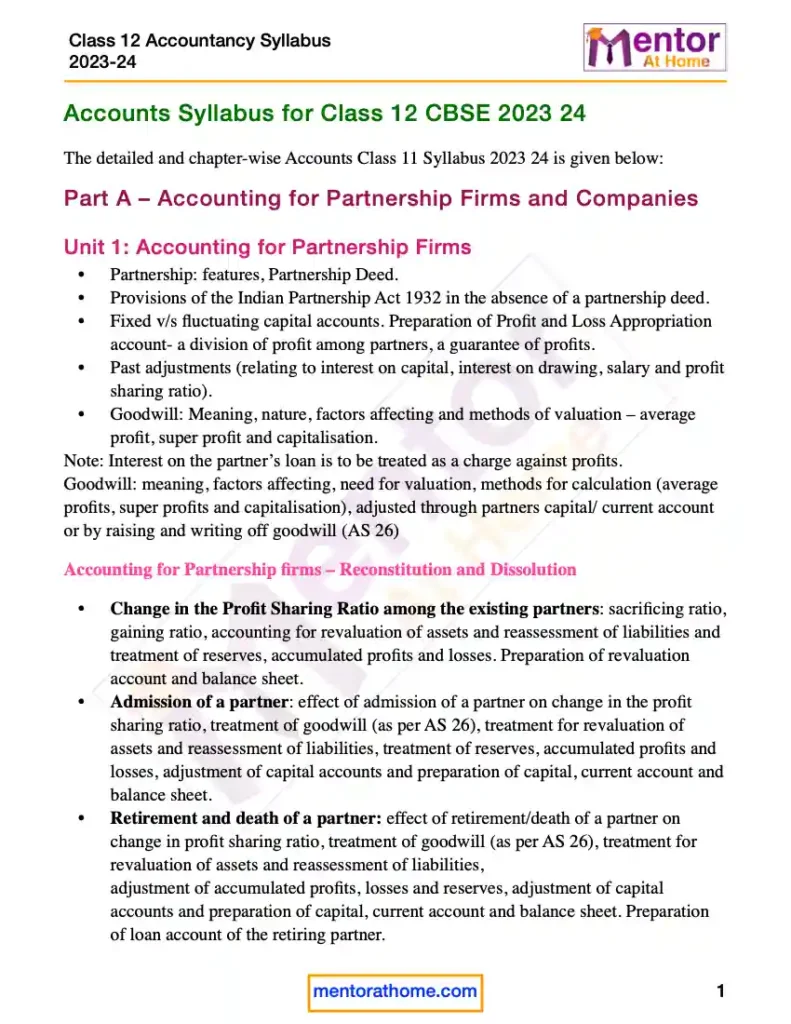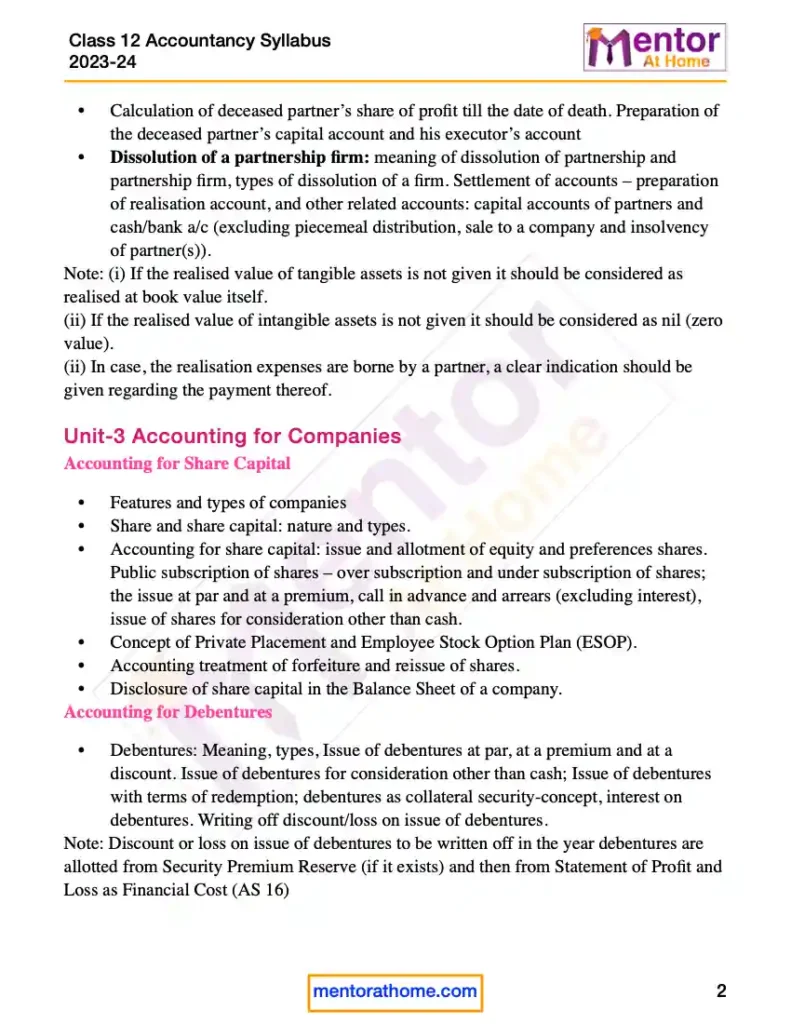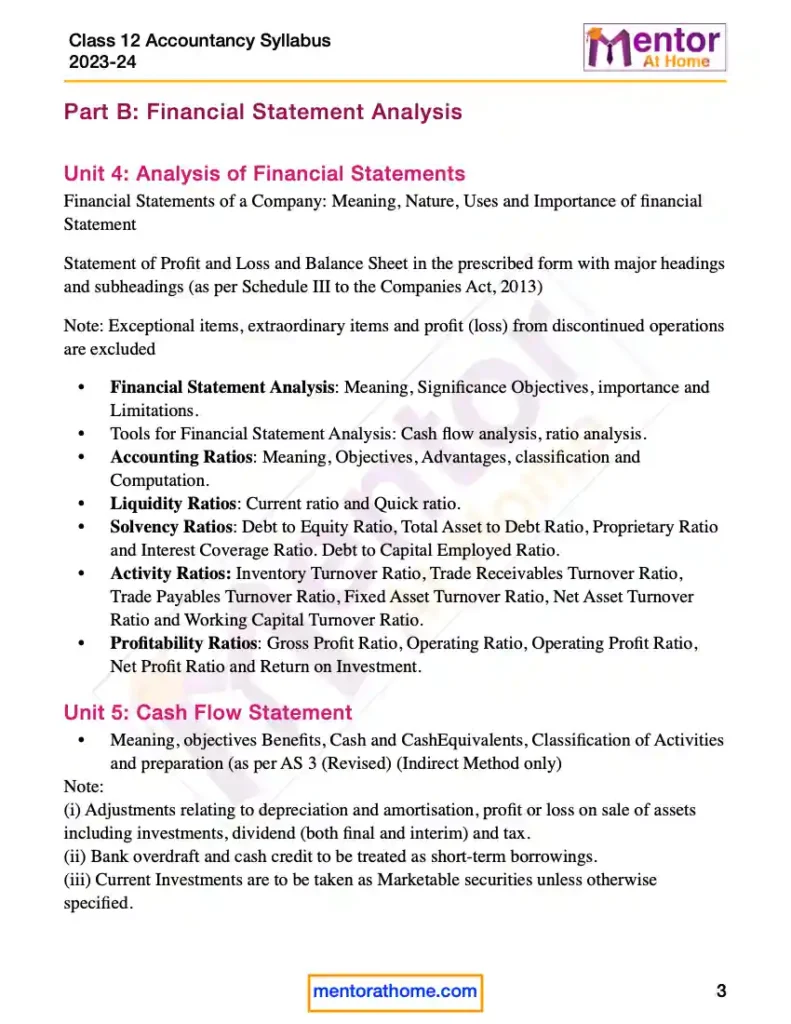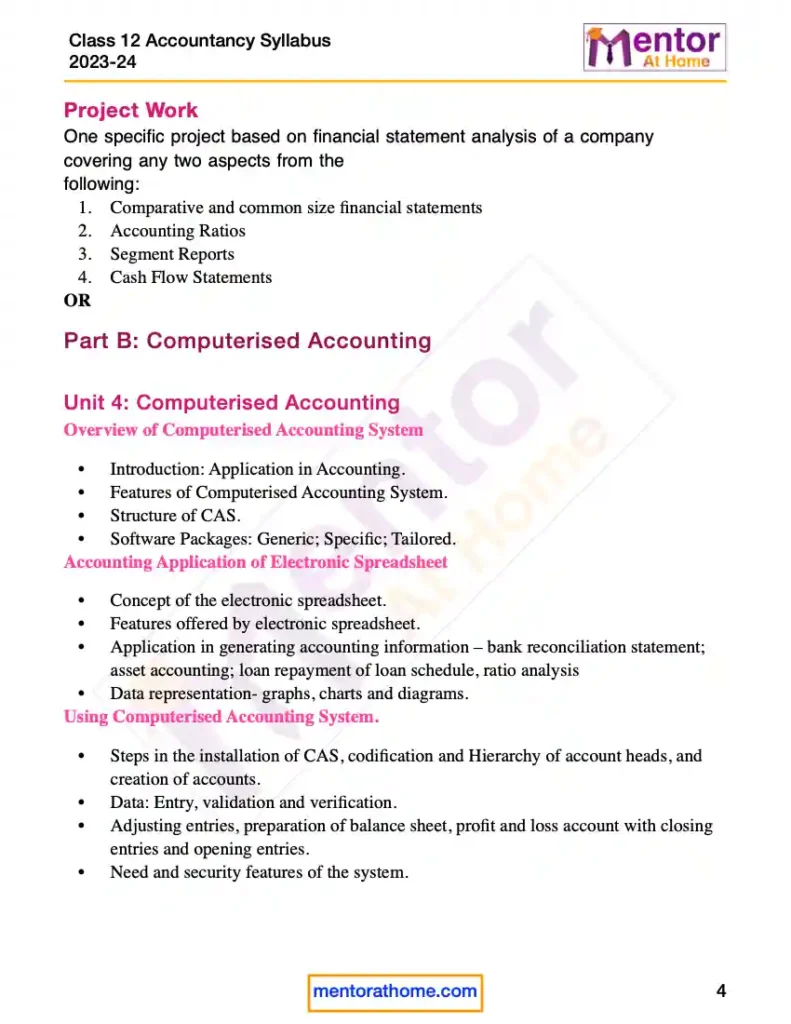Class 12th Accounts Syllabus 2023-24
Here we provide the latest CBSE Class 12 Accounts Syllabus 2023 24. You can also Download the new and revised CBSE Accountancy syllabus class 12 PDF. The present revised syllabus of class 12 Accountancy has been designed in accordance with National Curriculum Framework 2005.
Accountancy is a scoring subject but needs a lot of practice and conceptual understanding of the topics. CBSE Accountancy syllabus class 12 helps you understand the important topics. We advise you to read the CBSE class 12 Accountancy syllabus 2023 24 carefully. Class 12th Accountancy syllabus also helps you in preparation for competitive exams like IIT, AIEEE etc.
You may also like
- Class 12 NCERT Solution
- Class 12 NCERT Books
- Class 12 NCERT Notes
- Class 12 Syllabus for all Subjects
CBSE Class 12 Accounts Syllabus 2023-24 Pdf
Click Here to Download the Class 12 Accountancy Syllabus Pdf
Accounts Syllabus for Class 12 CBSE 2023 24
The detailed and chapter-wise Accounts Class 12 Syllabus 2023 24 is given below:
Part A – Accounting for Partnership Firms and Companies
Unit 1: Accounting for Partnership Firms
- Partnership: features, Partnership Deed.
- Provisions of the Indian Partnership Act 1932 in the absence of a partnership deed.
- Fixed v/s fluctuating capital accounts. Preparation of Profit and Loss Appropriation account- a division of profit among partners, a guarantee of profits.
- Past adjustments (relating to interest on capital, interest on drawing, salary and profit sharing ratio).
- Goodwill: Meaning, nature, factors affecting and methods of valuation – average profit, super profit and capitalization.
Note: Interest on the partner’s loan is to be treated as a charge against profits.
Goodwill: meaning, factors affecting, need for valuation, methods for calculation (average profits, super profits and capitalization), adjusted through partners capital/ current account or by raising and writing off goodwill (AS 26)
Accounting for Partnership firms – Reconstitution and Dissolution
- Change in the Profit Sharing Ratio among the existing partners: sacrificing ratio, gaining ratio, accounting for revaluation of assets and reassessment of liabilities and treatment of reserves, accumulated profits and losses. Preparation of revaluation account and balance sheet.
- Admission of a partner: effect of admission of a partner on change in the profit sharing ratio, treatment of goodwill (as per AS 26), treatment for revaluation of assets and reassessment of liabilities, treatment of reserves, accumulated profits and losses, adjustment of capital accounts and preparation of capital, current account and balance sheet.
- Retirement and death of a partner: effect of retirement/death of a partner on change in profit sharing ratio, treatment of goodwill (as per AS 26), treatment for revaluation of assets and reassessment of liabilities,
adjustment of accumulated profits, losses and reserves, adjustment of capital accounts and preparation of capital, current account and balance sheet. Preparation of loan account of the retiring partner. - Calculation of deceased partner’s share of profit till the date of death. Preparation of the deceased partner’s capital account and his executor’s account
- Dissolution of a partnership firm: meaning of dissolution of partnership and partnership firm, types of dissolution of a firm. Settlement of accounts – preparation of realization account, and other related accounts: capital accounts of partners and cash/bank a/c (excluding piecemeal distribution, sale to a company and insolvency of partner(s)).
Note: (i) If the realized value of tangible assets is not given it should be considered as realized at book value itself.
(ii) If the realized value of intangible assets is not given it should be considered as nil (zero value).
(ii) In case, the realization expenses are borne by a partner, a clear indication should be given regarding the payment thereof.
Unit-3 Accounting for Companies
Accounting for Share Capital
- Features and types of companies
- Share and share capital: nature and types.
- Accounting for share capital: issue and allotment of equity and preferences shares. Public subscription of shares – over subscription and under subscription of shares; the issue at par and at a premium, call in advance and arrears (excluding interest), issue of shares for consideration other than cash.
- Concept of Private Placement and Employee Stock Option Plan (ESOP).
- Accounting treatment of forfeiture and reissue of shares.
- Disclosure of share capital in the Balance Sheet of a company.
Accounting for Debentures
- Debentures: Meaning, types, Issue of debentures at par, at a premium and at a discount. Issue of debentures for consideration other than cash; Issue of debentures with terms of redemption; debentures as collateral security-concept, interest on debentures. Writing off discount/loss on issue of debentures.
Note: Discount or loss on issue of debentures to be written off in the year debentures are allotted from Security Premium Reserve (if it exists) and then from Statement of Profit and Loss as Financial Cost (AS 16)
Part B: Financial Statement Analysis
Unit 4: Analysis of Financial Statements
Financial Statements of a Company: Meaning, Nature, Uses and Importance of financial Statement
Statement of Profit and Loss and Balance Sheet in the prescribed form with major headings and subheadings (as per Schedule III to the Companies Act, 2013)
Note: Exceptional items, extraordinary items and profit (loss) from discontinued operations are excluded
- Financial Statement Analysis: Meaning, Significance Objectives, importance and Limitations.
- Tools for Financial Statement Analysis: Cash flow analysis, ratio analysis.
- Accounting Ratios: Meaning, Objectives, Advantages, classification and Computation.
- Liquidity Ratios: Current ratio and Quick ratio.
- Solvency Ratios: Debt to Equity Ratio, Total Asset to Debt Ratio, Proprietary Ratio and Interest Coverage Ratio. Debt to Capital Employed Ratio.
- Activity Ratios: Inventory Turnover Ratio, Trade Receivables Turnover Ratio, Trade Payables Turnover Ratio, Fixed Asset Turnover Ratio, Net Asset Turnover Ratio and Working Capital Turnover Ratio.
- Profitability Ratios: Gross Profit Ratio, Operating Ratio, Operating Profit Ratio, Net Profit Ratio and Return on Investment.
Unit 5: Cash Flow Statement
- Meaning, objectives Benefits, Cash and CashEquivalents, Classification of Activities and preparation (as per AS 3 (Revised) (Indirect Method only)
Note:
(i) Adjustments relating to depreciation and amortization, profit or loss on sale of assets including investments, dividend (both final and interim) and tax.
(ii) Bank overdraft and cash credit to be treated as short-term borrowings.
(iii) Current Investments are to be taken as Marketable securities unless otherwise specified.
Project Work
One specific project based on financial statement analysis of a company covering any two aspects from the
following:
- Comparative and common size financial statements
- Accounting Ratios
- Segment Reports
- Cash Flow Statements
OR
Part B: Computerised Accounting
Unit 4: Computerised Accounting
Overview of Computerised Accounting System
- Introduction: Application in Accounting.
- Features of Computerised Accounting System.
- Structure of CAS.
- Software Packages: Generic; Specific; Tailored.
Accounting Application of Electronic Spreadsheet
- Concept of the electronic spreadsheet.
- Features offered by electronic spreadsheet.
- Application in generating accounting information – bank reconciliation statement; asset accounting; loan repayment of loan schedule, ratio analysis
- Data representation- graphs, charts and diagrams.
Using Computerized Accounting System.
- Steps in the installation of CAS, codification and Hierarchy of account heads, and creation of accounts.
- Data: Entry, validation and verification.
- Adjusting entries, preparation of balance sheet, profit and loss account with closing entries and opening entries.
- Need and security features of the system.
Part C: Practical Work
Please refer to the guidelines published by CBSE
Booklist to Cover Class 12th Accountancy Syllabus
- Financial Accounting -I Class XI NCERT Publication
- Accountancy -II Class XI NCERT Publication
- Accountancy -I Class XII NCERT Publication
- Accountancy -II Class XII NCERT Publication
- Accountancy – Computerised Accounting System Class XII NCERT Publication
Class 12 Accountancy Syllabus 2023- 24 – Course Structure
Before you read the Class 12th Accountancy syllabus you have to understand the course structure to complete the accounts Class 12 Syllabus 2023 24.
| Units | Period | Marks | |
| Part A | Accounting for Partnership Firms and Companies | ||
| Unit 1. Accounting for Partnership Firms | 105 | 36 | |
| Unit 2. Accounting for Companies | 45 | 24 | |
| 150 | 60 | ||
| Part B | Financial Statement Analysis | ||
| Unit 3. Analysis of Financial Statements | 30 | 12 | |
| Unit 4. Cash Flow Statement | 20 | 8 | |
| 50 | 20 | ||
| Part C | Project Work | 20 | 20 |
| Project work will include: | |||
| Project file | 12 | ||
| Viva voce | 8 | ||
| OR | |||
| Part B | Computerized Accounting | ||
| Unit 4. Computerized Accounting | 50 | 20 | |
| Part C | Practical Work | 50 | 20 |
| Practical work will include: | |||
| Practical file | 12 | ||
| Viva voce | 8 |



